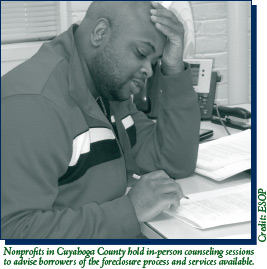February/March 2010
In this Issue
Returning Foreclosures to Productive Use with Land Banks
Preventing Foreclosures, One Community at a Time
Fighting Blight Pays in Philadelphia
Resilience Matters in Foreclosure Crisis
In the next issue of ResearchWorks
Preventing Foreclosures, One Community at a Time
With foreclosures expected to reach 2.4 million nationwide in 2009, the consequences of mortgage defaults are far reaching.1 Some localities are taking steps to counteract these effects with foreclosure mitigation. Three communities-Cuyahoga County, Ohio; Philadelphia, Pennsylvania; and the state of Connecticut-have each created unique programs with proven track records of preventing foreclosures. The cornerstone of all three programs is outreach and borrower education with third-party assistance, without which homeowners might not be adequately prepared to navigate the services available. Two of the programs operate a hotline linking borrowers with counselors who are able to assist them. Outreach efforts of one locality also include public service announcements and going into neighborhoods to notify buyers of their upcoming conferences, as well as informing them of the assistance being offered. Another promotes its services with a public service announcement and through financial literacy programs. The state-run program ensures that borrowers receive information by mail regarding the mediation program, once a foreclosure is filed.
 Cuyahoga County's Foreclosure Prevention Program
Cuyahoga County's Foreclosure Prevention Program
Cuyahoga County experienced more than 40,000 foreclosures between March 2006 and February 2009. The county's foreclosure problem is compounded by Ohio's extremely lengthy foreclosure process-at 192 days between foreclosure referral and sale, it is among the slowest in the nation.2 In response, Cuyahoga's Board of Commissioners initiated a 3-year pilot program designed to prevent foreclosures when possible, and to hasten the foreclosure process when that step becomes unavoidable. The county successfully sought to amend state law, thereby reducing the complexity and processing time of foreclosing on tax-delinquent abandoned and vacant properties. Automating the procedures for foreclosures within the courts and adding additional staff further expedited the process.3
Through homeowner education, nonprofit partners in the Cuyahoga County Foreclosure Prevention Program held 5,078 foreclosure prevention counseling sessions between 2006 and 2009.4 During these in-person meetings, homeowners were advised of the process and made aware of the services available. These meetings mitigated nearly 2,200 foreclosures.5
The program was expanded beyond the pilot period and continues today. A mediation program went into effect in 2008 after the Ohio Supreme Court directed counties to act. This expansion enables borrowers to opt-in to mediation once they have received a foreclosure notice from the court. Of the 2,416 cases in which homeowners chose to participate and were referred to mediation, 1,542 premediation conferences were held with 443 proceeding to mediation, where 231 of the mediated cases were resolved successfully.6
Philadelphia's Residential Mortgage Foreclosure Diversion Program
Philadelphia's program began in 2004 when the city's Sheriff canceled Sheriff's Sales and sought a moratorium on foreclosures. An appointed Mortgage Foreclosure Steering Committee helped the Philadelphia Court of Common Pleas create a foreclosure diversion pilot program to reduce the rate of delinquent mortgages. In this program, lenders (able to negotiate in person or by telephone) and eligible homeowners must meet before Sheriff's Sales can proceed, thus creating an opportunity to negotiate. Most of the cases are resolved during this time, without formal mediation. In the 25 percent of cases where borrowers do not attend the conferences, thereby waiving their right to mediation, judges make the determinations.
The results of the diversion program are significant. Since its inception in 2008, 6,300 conferences have been held and 1,600 homes have been saved from Sheriff's Sales. Approximately 3,000 more homeowners are currently scheduled for a conference or are awaiting action from the lender. Additionally, the rate of borrowers failing to appear has dropped from 50 percent at the program's outset to 30 percent.7
Connecticut's Foreclosure Mediation Program
Signed into law in 2008, Connecticut's program is statewide and run with state funds. Once a foreclosure complaint is filed, homeowners receive information in the mail about mediation services. Interested borrowers respond by mailing a form that signifies their interest to the court. A mediation session is then scheduled between eligible homeowners and servicers (the representatives must be legally empowered to enter into a settlement agreement). Of the 18,763 foreclosures filed in Connecticut between July 1, 2008 and March 31, 2009:
- Homeowners opted for mediation in 5,041 cases;
- Mediation was completed for 2,233 foreclosures;
- Lenders and homeowners came to a resolution for 1,630 foreclosures; and
- Approximately 80 percent of the agreements (1,313) allowed borrowers to stay in their homes.
Most of the mediation meetings resulted in interest rate or term changes, although other outcomes included "graceful exits" (both parties agreeing to allow the foreclosure to proceed), short sales, or signing the deed back to the lender. The remaining unresolved cases have at least reached the initial meeting stage and are ongoing.8
Each of these efforts to prevent foreclosures was created and implemented based on local needs and requirements. Other communities may review these successful programs and modify them to meet local demands. For more information, contact Paul Bellamy (pbellamy@cuyahogacounty.us) about Cuyahoga County, Roberta Palmer (Roberta.Palmer@jud.ct.gov) regarding Connecticut, and Rachel Gallegos (Rachel.Gallegos@courts.phila.gov) concerning Philadelphia.
1 Center for Responsible Lending, Soaring Spillover, 2009, p.1.
2 Kathryn W. Hexter and Molly Schnoke, Responding to Foreclosures in Cuyahoga County: Program Year Three Evaluation Report, 2009, p. 3; Todd Swanstrom, Karen Chapple, and Dan Immergluck, 2009, "Regional Resilience in the Face of Foreclosures: Evidence From Six Metropolitan Areas," p. 8.
3 Alan C. Weinstein, Kathryn W. Hexter and Molly Schnoke, Responding to Foreclosures in Cuyahoga County: A Pilot Initiative, 2008.
4 Hexter and Schnoke, p. 13.
5 Ibid, p. 20; Swanstrom, et al., p. 15.
6 Hexter and Schnoke, pp. 27-8.
7 Annette M. Rizzo, Testimony at Congressional Oversight Panel, Hearing on Foreclosure Mitigation Efforts under TARP, September 24, 2009.
8 Andrew Jakabovics and Alon Cohen, "It's Time We Talked: Mandatory Mediation in the Foreclosure Process," 2009, pp. 19-22.

